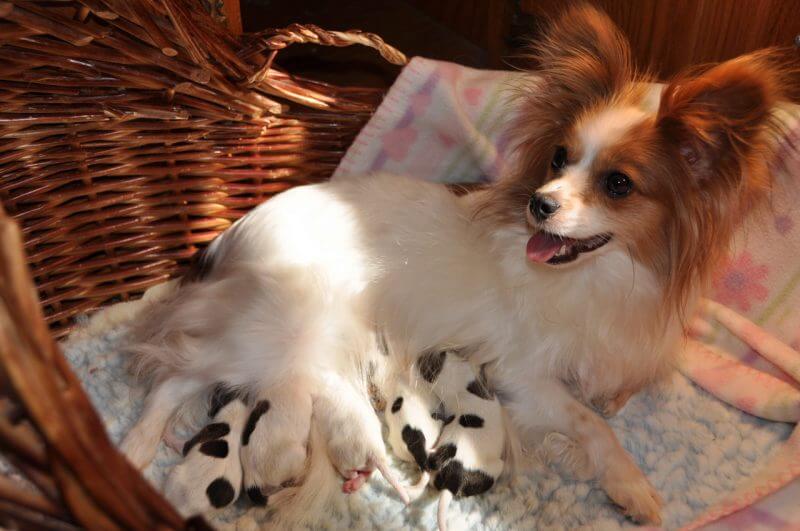Breeding papillons can be more problematic when compared to other dog breeds because of the breed’s small size. When thinking of breeding papillons, you have to understand what the breed’s history is, and where it is heading, in order to find suitable partners to better the breed, each litter at a time.
Just like with any breed, you must be fully aware of all health problems and breed-specific issues targeting the breed type you are working with. This is the ethical way to breed papillons that are going to live long happy lives. Dog breeding is not about putting two dogs together and await a miracle.
As a free blog very much specialized in dog breeding, we want to emphasize that you should only start a papillon kennel or plan a litter to improve your the Papillon breed as a whole. You should never be motivated by potential profits or consider this as a cool pastime.
So before wondering how to breeding papillons, one must have a huge knowledge of the breed and understand the mechanics behinds canine heredity. Then, the breeder has to set out some clear measurable goals against which he will review his evolution year after year.
The Butterfly Dog — Context and History
The Papillon is a friendly small toy dog with a fragile skeleton and frame. Such a thin and fine bone structure makes the Papillon light and a perfect lap dog. Because Papillons don’t have an undercoat, they require very little grooming despite having an abundant flowing and silky coat.

Papillons are often referred to as Butterfly Dogs because of their unique butterfly-like ears. They are far from being shy and usually described as alert, hard-to-please and very elegant in motion.
A purebred Papillon has to be either white with patches of any color or parti-color, meaning having a predominant color broken by patches of one or more other colors.
Despite their fragile appearance, Papillons are an easy breed to live with. They thrive in both cities or rural areas and aren’t bothered by either a cold or warm climate. A butterfly dog loves having an athletic owner to help him spend all the energy his little body has.

History
It’s only in 1915 that the American Kennel Club officially recognized the Papillon as its very own breed. The first official conformation shows started around 1935.
Marie Antoinette was a huge admirer of the dwarf spaniel, a former colloquial name given to the Papillon breed from the 16th century. The name papillon comes from the French and literally translates to butterfly.
Despite the breed and its actual name being rooted in France, the Papillon has known success in Spain and Italy where the breed became very popular and sought-after.
During those times, the hotbed for the trade of Papillon dogs was in Italy’s beautiful Bologna. These dogs were raised and sold all over Europe with no discrimination for either ear types. Erect-eared or drop-eared Papillons occurred in the same litters and are still judged together in AKC shows today.
Papillon breeding has always been to get a small company pet that is also able to chase and pursue a rat, without having the force to actually kill it. Some would call Papillons cats in a dog’s body.
How To Breed Papillons
Any toy breed going through pregnancy presents some risks, especially with the Papillon’s narrow pelvic girth. Additionally, papillon puppies are born with a large ration head to the body which often requires a C-section.
The papillon litter size is averaging three puppies, which is considered a small puppy count for the canine species. However, know that it’s also very common for a papillon bitch to give birth to a single puppy.
Gestation is of around 63 days or 9 weeks and extra care should be provided to the pregnant and nursing Papillon bitch because of her small bodies and support systems.
Everything else is the same as other dog breeds since they all are part of the very same canine species.

Health Problems When Breeding Papillons
With a life expectancy ranging from 12 to 16 years, the Papillon is a small but very solid toy breed. However, there are still several health conditions that are affecting Papillons that a breeder should be aware of in order to eradicate them from his bloodline.
Neuroaxonal Dystrophy Disease (NAD)
Only recently appeared in the Papillon breed, Neuroaxonal Dystrophy Disease (NAD) is a disorder where both spinal cord and brain swell progressively in the young puppy. NAD starts a little before the puppy’s 7th to 8th week and euthanasia is usually required by the 20th week of age.
A wobbling head and very poor coordination with the puppy commonly falling at random times are signs of the NAD deteriorating the puppy’s motor functions.
Neuroaxonal Dystrophy Disease is a genetic disorder where both parents must carry the gene in order to have the puppy affected. Although the disease is rare, it is spreading faster and scientists are yet to find the genetic marker.
Eyes Conditions
Appearing at around 3 to 4 years of age, Progressive Retinal Atrophy (PAR) is the most common eye condition for Papillons and many other dog breeds out there. PAR is actually a group of genetic conditions characterized by the degeneration of the retina in both eyes, causing a progressive loss of vision and eventually, total blindness.
Also common, cataracts may affect our butterfly dogs between 6 months old and 8 years old. Make sure your vet checks your dog’s eyes thoroughly at least once a year.
Patellar Luxation
Common is most toy breeds, patellar luxation is the most common orthopedic problem in Papillons. This is why anybody thinking of breeding papillons should understand how to avoid your papillon’s kneecap (patella) from being dislocated from its normal anatomic position, in the groove of the thigh bone.
Patellar luxations are either caused by a genetic predisposition leading to a malformation of the kneecap, or a trauma that occurred during the dog’s life.

Generally, the owner will see signs after a handful of months if the issue is genetic, an X-ray is also recommended just to be on the safe side. Visit your vet as soon as you notice your dog is limping or skipping in his gait. An unusual sitting posture can also be an indicator of a patellar luxation onset.
Injuries
Alright, I know. Injuries are not illnesses but they are the first cause of physical and mental issues in Papillons. They are so small and fragile that even falling from a few stairs can hurt them badly.
Bone fractures are a leader in this category since a simple inoffensive jump from your lap to the floor can fracture a bone if the landing is missed, or the floor slippery.
[adwithin]
We would recommend you to visit this great page for more medical conditions found within the Papillon breed.
Future of the Papillon Breeding
The Papillon breed is somewhat being spared by the viral trends showcasing ever-smaller toy breeds. Papillon breeders should stick to the current standard and avoid any drift if they want to keep the breed as healthy as it is today.
Papillon breeding is not more or less complicated than with any other dog breed, but more care should be provided throughout the pregnancy and whelping because of the breed’s very small size.
Breeding papillons should be done responsibly we always recommend liaising with your national and regional Papillon clubs to get feedback from them on your breeding program’s ambition. Pay a quick visit to the Papillon Club of America and their health and genetics sections.

If you are ready to breed your papillon dog, make sure you get your whelping kit ready and grab a copy of our bestseller, The Dog Breeder’s Handbook.


One comment on “Breeding Papillons — Introduction On How To Breed Papillons”
‘How to breed Papillons’ the book. Loved the article but there is no where to click for the book you mention.